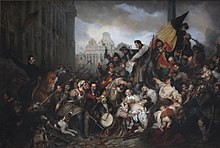In 1516 Charles V, who had been heir of the Low Countries since 1506, was declared King of Spain in St. Michael and St. Gudula Cathedral in Brussels. Upon the death of his grandfather, Maximilian I, Holy Roman Emperor in 1519, Charles became the new ruler of the Habsburg Empire and was subsequently elected the Holy Roman Emperor. It was in the Palace complex at Coudenberg that Charles V abdicated in 1555. This impressive palace, famous all over Europe, had greatly expanded since it had first become the seat of the Dukes of Brabant, but it was destroyed by fire in 1731.
In 1695, during the Nine Years' War, King Louis XIV of France sent troops to bombard Brussels with artillery. Together with the resulting fire, it was the most destructive event in the entire history of Brussels. The Grand Place was destroyed, along with 4000 buildings, a third of all the buildings in the city. The reconstruction of the city centre, effected during subsequent years, profoundly changed the appearance of the city and left numerous traces still visible today. The city was captured by France in 1746 during the War of the Austrian Succession but was handed back to Austria three years later.
Brussels remained with Austria until 1795, when the Southern Netherlands was captured and annexed by France. Brussels became the capital of the department of the Dyle. It remained a part of France until 1815, when it joined the United Kingdom of the Netherlands. The former Dyle department became the province of South Brabant, with Brussels as its capital.
Late modern
Episode of the Belgian Revolution of 1830, Wappers (1834)
Place Royale, late 19th century
Following independence, the city underwent many more changes. Brussels became a financial centre thanks to the dozens of companies put into orbit by the Société Générale de Belgique. In 1835, the first passenger railway built outside England linked Brussels with Mechelen. In the 19th century, the population of Brussels grew considerably. The Senne had become a serious health hazard, and from 1867 to 1871, under the tenure of mayor Jules Anspach, its entire course through the urban area was completely covered over. This allowed urban renewal and the construction of modern buildings of hausmannien style along central boulevards, characteristic of downtown Brussels today. Buildings such as the Brussels Stock Exchange (1873), the Palace of Justice (1881) and Saint Mary's Royal Church (1885) date from this period.


No comments:
Post a Comment